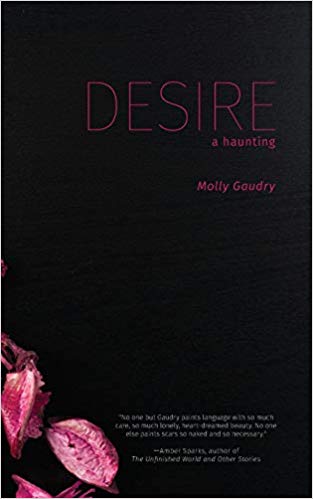Molly Gaudry’s Desire: A Haunting presents a familial love story where most characters are no longer in the realm of the living. This is a novella made poetry through line breaks and the interweaving of fantasy into otherwise realistic lives of gourmet elegance and past violent trauma.
In a seaside cottage, a speaker encounters the first and most persistent of many ghosts, Pearl Prynne (the more famous Hester Prynne’s daughter) who chooses to go by the name ‘Ogie’ – a kinder, gentler form of ‘ogre.’ Ogie and the narrator establish an unlikely years-long friendship, cemented by the fact that both seem incredibly alone.
The setting, while replete with cherry blossoms, herbs, lovely scenic views, and food and cocktails that the characters prepare in poetic sequences that could fit into a cookbook, doesn’t contain many live humans. The few whom the narrator does interact with at the local markets are wallpaper characters and the exchanges become awkward due to the vivacious ghosts’ invisible actions and sense of humor.
The ghosts, starting with Ogie, who’s thirsty and enjoys pretending to eat and drink at the narrator’s table, come to life physically and emotionally on Gaudry’s pages. They request their favorite foods, care about what they’re wearing and how they look, celebrate present-day holidays in real time, and get injured in ways that require stitches.
For a book that’s populated by ghosts and fragmented memories, there’s a lot of emphasis on the ‘present moment.’ Current holidays and seasons pull the story along and serve to transition between scenes and interludes. Ogie becomes bored and wants the narrator to join her in drawing as a hobby, something to ‘pass the long autumn hours.’ Today’s world doesn’t disappear, even when we become absorbed with the past.
A theme of nurturance and caregiving emerges: Ogie adopts a ghost-boy, William, who needs to be looked after, who wants and takes in a pet rabbit. Characters, real and otherwise, need clothing that has to be mended with care, and people give each other gifts.
And while she takes awhile to get there, and first gives a few fanciful renditions of her past and her death, Ogie reveals that she knew the narrator’s mother and helped to care for the narrator as a child after a nearly-unspeakable tragedy. The narrator’s childhood memories, as well as Ogie’s own past tragedy and loss, only come near the end in a section that offers the closest to a literal rendition of events that this book gives.
This, and the ending, suggest that the point of this story is that Ogie, William, the narrator, and others have learned how to get along and care for each other as a little family. Knowing who everyone is, exactly what happened, and when, is somewhat incidental.
Perhaps it is this implied focus on love and care, rather than linear memory, that can facilitate healing from the trauma and betrayal of the past. There is definitely tragedy and pain in the narrator and her family’s past, and Gaudry conveys this through style as well as plot. She crafts flowing lines of both languid and purposeful beauty, then screams, through capital letters and occasional pages with only one single word, about what and who cannot be ignored.
This tale does not offer a clear progression out of the past into the present or the future, or from ‘victim’ to ‘survivor’ as readers have come to expect. Even as both main characters grow stronger, they remain involved with the ghost-world, as the narrator clothes a whole new cast of phantoms.
In keeping with the poetic, implicit style of this book, there’s no concrete atonement, restitution or forgiveness for past wrongdoing. Even an actual apology isn’t passed on directly: the narrator sometimes backs off, leaving the ghosts to communicate with each other rather than passing messages through her.
Yet, we see constant motifs of cooking, washing, clothing and mending, and the narrator and ghosts find ways to continue to interact with and nurture each other. Through these, and by the story’s resistance of linear narrative that would include a scorekeeping account of wrongdoings, Gaudry’s work points to a subtler sense of peacemaking and restoration.


Pingback: Synchronized Chaos July 2019: Presence and Absence | SYNCHRONIZED CHAOS